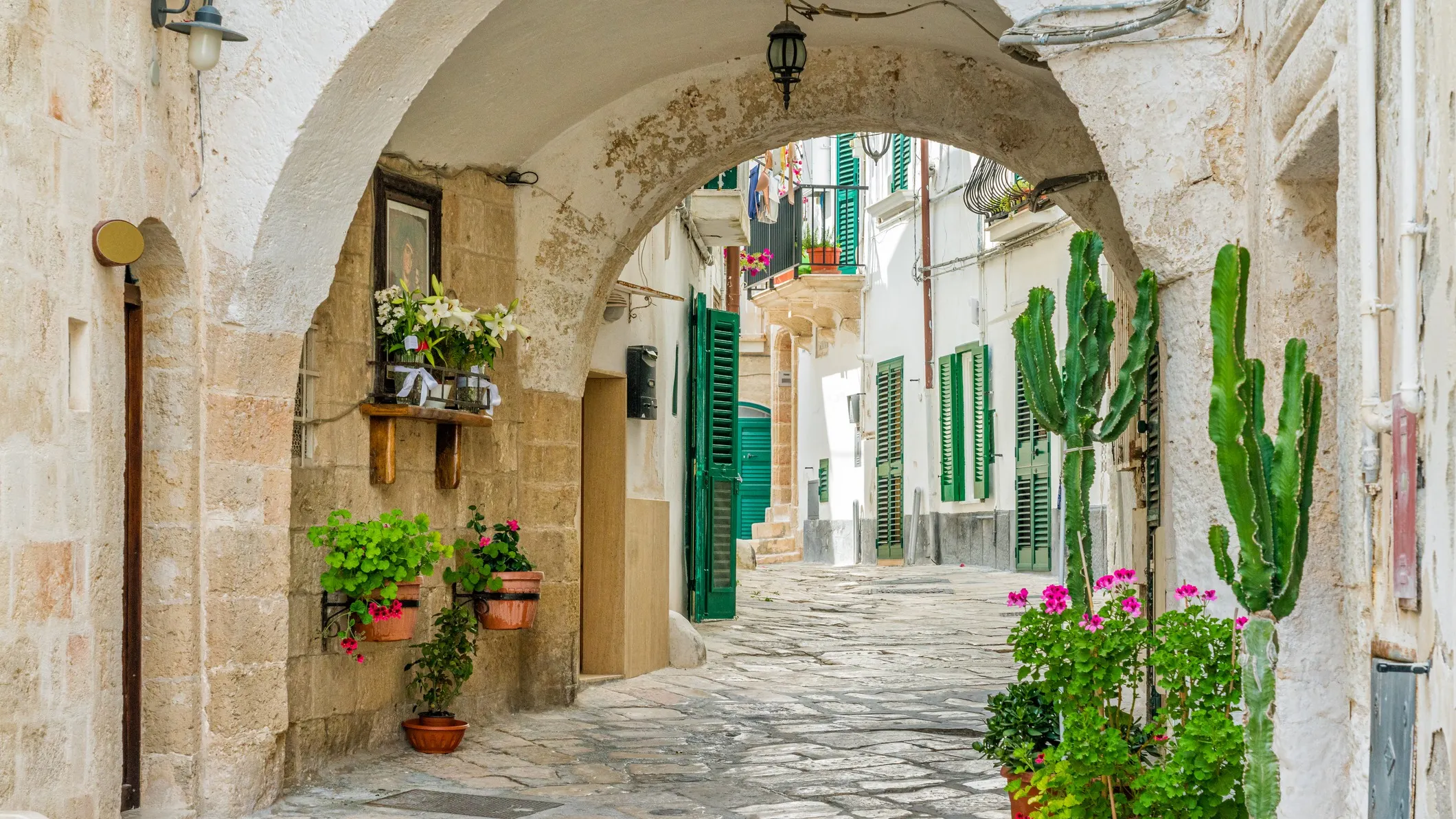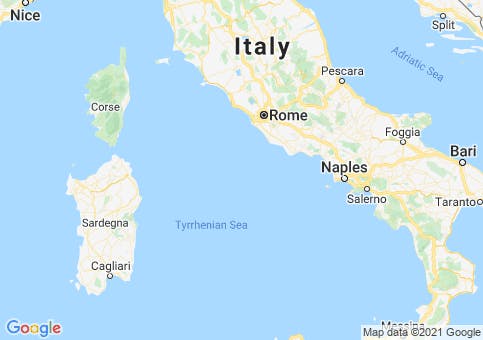By Anne Rose
Bari is a bustling central city and also the capital of the Bari province in southern Italy’s Puglia region, on the heel of the Adriatic Sea coastline.
Appealing to tourists and retirees alike, Bari is home to numerous shops (local mom-and-pops as well as high-end designer goods), museums, theaters, universities, a train, and bus hub from which to explore points north, south, and inland, an airport, and a cruise terminal.
Get Your Free Italy Report Today!
Get Your Free Italy Report Today!
Learn more about Italy and other countries in our daily postcard e-letter. Simply enter your email address below and we’ll send you a FREE report – Italy: Europe’s Most Seductive Country.

By submitting your email address, you will receive a free subscription to IL Postcards, Overseas Dream Home, The Untourist Daily and special offers from International Living and our affiliates. You can unsubscribe at any time, and we encourage you to read more about our Privacy Policy.
Retire in Bari

The climate is typical Mediterranean with four distinct seasons. Winter is seldom cold, more chilly and rainy. Spring and autumn are perfectly delightful shirt sleeve weather with an abundance of blooming plants or harvests of olives, grapes, and chestnuts. Summer can be extremely hot, exacerbated by high humidity because of its perch on the sea.
But it also brings a profusion of organically grown produce, flavorful, colorful, and economical. Picture-perfect red tomatoes that look to have been photoshopped, sweet and juicy watermelons, mounds of fresh purple garlic bulbs (with stalks attached so you can try your hand at braiding the garlic!), peppers of every color and shape. The food is just one enticing reason to move to Italy.
Wines are cheap and plentiful but delicious. They’re only inexpensive because Puglia hasn’t yet learned how to market and distribute their incredible varietals, such as Verdeca, Primitivo, Negroamara, Castel del Monte, Nero di Troia, to name a few; these are nearly impossible to find outside of Puglia, so take advantage of these while you’re here. Just yesterday, we bought an amazing local Castel del Monte for only $3 a liter. That wine in the U.S. would easily command $20 or more.
If you ever pictured yourself sipping a glass of vino in Italy, this is the most affordable, and arguably the tastiest, province to actualize your dream!
Lifestyle in Bari

From Bari Centrale’s main train hub, buses are waiting outside to drive you to inland villages, possibly not served well by trains. At this writing, a $1.20 ticket will conveniently take you to the airport or the cruise pier. One block from Bari Centrale is the privately operated Appulo Lucane train station that will whisk you through scenic, fertile farmlands to the Basilicata region next door to Puglia, and home of Matera, 2019s UNESCO City of Culture.
Suffice to say that if exploring Puglia is on your radar, Bari city is a centrally located and convenient base with its numerous transportation modes and proximity to other beautiful Pugliese towns, such as Polignano a Mare, Alberobello, Ostuni, Monopoli, Martina Franca, Cisternino. Margherita di Savoia, and Matera. It is easy to explore the entire Bari province and the region beyond using public transportation. No car is needed, which is a huge saving. And trains and buses are inexpensive: $1.70 usually to go to the next town whether by train or bus. The most we have spent on trains was less than $20 roundtrip from Bari to the southern end of the province.
Even without venturing further afield, Bari has plenty to offer besides the aforementioned shops and museums. Old Town Bari (Centro Storico/Bari Vecchia) is a maze of cobbled streets that you’ve imagined as iconic Italy. Whitewashed stone buildings, arches galore, and streets that better resemble alleys. To those tangled streets, add loads of little shops selling authentic Barese wares and foods (homemade taralli anyone?), and you can browse for hours on end.
Need a snack? Tuck into one of the ubiquitous eateries offering Barese specialties like orecchiette, fish, or of course, pizza) or grab to-go focaccia (Bari’s unique version of a different kind of pizza made with semola flour) or panzerotti at a bakery and snack while you walk, like the locals do.
The little, ear-shaped pasta, called orecchiette, are a staple of Bari diets. The best ones are handmade, and you can see this age-old art still practiced by elderly women in the streets of Old Town. Watch their fingers fly from decades of dedicated practice (I have tried numerous times to get that unique shape, and the closest I can come is a cavatelli wannabe), and then buy a bag, fresh-made before your eyes, for your night’s supper. Or buy some cime di rape at the produce monger next door to complete your authentic meal of orecchiette con cime di rape.
Cost of Living in Bari

Italy’s economy is in a current slump, and landlords have been eager to rent, owners eager to sell. It is a buyer’s market now. Compact, furnished little studio apartments can be had for as little as $420 a month. Seaview apartments and more upscale rental homes command higher prices that we’ve seen as high as $1,300 a month. The average is somewhere in between. One tip is to contact a realtor selling homes to inquire if the owners would consider renting until it’s sold. That’s what we did: this independent stone house has been on the market for six years, empty, so we offered a two-year long-term rental for $770 a month which was eagerly accepted. One-bedroom, two-bathrooms, well-stocked kitchen (we didn’t have to buy one dish, one pot, or fork), fully furnished (even with linens!), and an amazing sea view rooftop terrace. Bargains to be had!
Food is inexpensive in Bari, particularly if you shop like the locals at the farmers’ markets for your fresh produce, fresh fish, and fresh cheeses. Buying direct from the local farmers (the original farm-to-table concept) ensures that your food is fresher, riper, and more economical by cutting out numerous layers of middlemen.
Not just food outlets, these markets also sell housewares, linens, clothing, and shoes. All economically priced. I’ve bought lovely cotton dresses for just over $7 and 100% linen shirts for $3.50—less costly than the fabric alone would cost if I even tried to sew it myself.
Because of the abundance of restaurants in Bari, dining out doesn’t need to break the bank either. A full-size 12 inch Margherita or marinara pizza can cost less than $5. A fancier dinner of fava bean puree appetizer (with taralli for dipping), a pasta or meat entrée, and a glass of wine will only set you back $30 or less for two people. The key is to eat like the locals and not order food imported from other countries, or order foods out of season. The Italian style of eating is easy, natural, and wholly satisfying.
Healthcare is substantially cheaper than in the U.S. A doctor’s visit might set you back $30 to $60. Recent dental work has been less than $120 for replacement fillings after a complimentary one-hour consultation. Full dental X-rays that took 15 minutes total from the waiting room to X-rays-in-hand were around $30. Our five prescription meds, for both of us, cost approximately $35 a month; in comparison, back in the U.S., my one prescription alone cost $60 a month. And if you become a legal resident, you can apply for a healthcare card. But we have not needed it as our costs are so minimal that we can pay out of pocket.
Entertainment costs can vary according to how often you go to the movies or theaters or nightclubs. We prefer instead the free entertainment of our landscape—picnicking by the ocean, walks along the lungomare, a gelato while people-watching in the piazza, or one of the numerous free concerts in the piazza. Most paid events hover in the $9 to $18 range. Are cooking classes your kind of entertainment? Figure on about $60 for a private two-hour class.
| Expense | U.S.$ |
|---|---|
| Rent | $770 |
| Groceries | $240 |
| Cable TV | $60 |
| Internet/Phone | $60 |
| Water | $24 |
| Gas/Electricity | 60 |
| Entertainment | $120 |
| Transportation | $100 |
| Healthcare | $60 |
| Total: | $1,494 |
Things to Do in Bari
By Daniela Perez
The city of Bari is located on the Adriatic Sea. It is the capital of the southern region of Puglia, as well as the second largest city in the south. Bari has the largest port on Italy’s Adriatic coast, and with its access to numerous shipping routes the city is the foremost economic center in the region after Naples.
But Bari is more than a port. It is truly an off-the-beaten-path destination, boasting spectacular food, castles, churches, and friendly people. Getting to town is very easy by taking the high-speed train from any city in Italy, or by plane from any major city in Europe. You can also take the adventurous route, crossing the Adriatic Sea by ferry from Albania, Montenegro, or Croatia. Whichever form of transportation you decide, Bari will be proud to show you its southern hospitality.
Here is a list of the best things to do while you are in town.
1. Bari Old Town
Just wandering in the labyrinth of streets of the Old Town brings joy to any traveler. These streets are full of architectural heritage as well as crawling with life, smells, and sounds. Make time to browse them during the day as well as at evening when most Italians go outside to talk and catch up with neighbors.
The Old Town’s architectural heritage is evident in buildings and through many arches that you will see while walking around town. In the past years, the government has invested in the neighborhoods, restoring buildings and controlling mafia groups. Walking around Old Town is safe, and you will see that this is a vital part of the story of Bari.
2. Basilica Di San Nicola
This Basilica is a solid example of Roman architecture, dating back to the 12th century. The first Norman church built in Southern Italy, it was constructed to house the remains of St. Nicholas, also known as Santa Claus.
Today, the Basilica is an important place of pilgrimage for both Catholics and Orthodox Christians believing that St. Nicholas’ tomb has special powers. Next to the church, there is the Museum Nicolaiano displaying items related to the Basilica.
3. Cathedral of St. Sabinus
This is the main church of Bari located at the entrance of Bari’s Old Town. Its architecture is Apulian Romanesque and it was built in the 13th century. The church keeps precious archeological finds in its basement, like a small Byzantine church and civic buildings from the Roman Empire.
Inside the church, there are 16 columns that support the structure, as well as marbles that enhance the icon of the Madonna Odegitria. The relics of St. Sabinus are on the main altar. The church also houses the Diocesan Museum which has important artworks.
4. Castello Svevo
This is one of the most important monuments of the city of Bari. The Castello Svevo was first built by the Norman King Roger II in the 13th century above a residential building from the Byzantine era. After the destruction of the city of Bari by William the Bad, the Castello was rebuilt by Frederick II of Swabia between the years 1233 and 1240.
Isabella of Aragon and her daughter Bona Sforza transformed the Castle in the 16th century, building a massive curtain wall with bastions around the building for protection.
Today the Castle is a museum with spaces open to the public to use for exhibitions of art or special events.
5. Homemade Pasta
Via dell’Arco Basso is a street known for cleaning laundry and drying fresh pasta. Here grandmas wake up early to make homemade orecchiette, the city’s renowned ear-shaped pasta, which is dried in mesh screens of wooden trays outside their doorways. Ladies sell their pasta to locals and tourists by the kilo. Grandmas here have been continuing this tradition for centuries.
6. Teatro Petruzzelli
The building is in the Umbertino style, an Italian style of the late-19th century. The building’s architecture melds glamorous with the modern buildings of the new district. It is Italy’s fourth-biggest theater, and the largest private theater in Europe. It is one of the most important cultural buildings in the region of Puglia.
The building was inaugurated in 1903, destroyed by an arson attack in 1991, and reconstructed in 2009 exactly to its former splendor. The theater seats 1,500 spectators with a variety of rich, artistic programs through the year. Famous performers like Frank Sinatra and Luciano Pavarotti have enchanted their audiences here.
7. Porto Vecchio
In this harbor, you can see colorful fishing boats any time of the day by the calm waters of the Mediterranean Sea. However, the most interesting time is in the morning when you see fishermen unload and sell their fresh catch of the day at the pier.
8. Eat Gelato
It would be a sin to leave Bari without trying one of its specialties, gelato. In any direction you turn, you will see a shop selling the delicious snack. Flavors available are dependent on the season, but they will have some surprising Italian options.
9. Beach and Lido San Francesco
At the east of the center of Old Town, you can find the beach and Lido San Francesco. This area is one of the most relaxing spots in town. The Mediterranean Sea provides golden sand and clear, blue water beaches. These are the perfect conditions to bring calm to the business of everyday life. Here you can also find shops, restaurants, and bars. You will be happy you are in Italy.
10. Lungomare Nazario Sauro
Bari’s coastal line makes for a tranquil promenade, known as the Lungomare Nazario Sauro. This scenic walkway with historic architecture and whitewashed buildings on one side and with sublime, blue sea views on the other runs for more than half a mile from the harbor of Porto Vecchio to the Parco per Cani.
Evening walking on the promenade is a local pastime, as well as the perfect place for a glorious sunset.
11. Piazza Mercantile
Piazza Mercantile has been the heart of the city’s commercial business district since the 14th century. Locals and tourists gather here to visit restaurants as well as to watch international cultural events.
The piazza is surrounded by historical buildings that once represented the power of local aristocrats, such as the 13th-century column of Justice and a stern-looking stone lion.
This piazza is a hub for city nightlife in Bari during the summer months.
Featured Image Copyright: ©iStock.com/Sky_Blue
Get Your Free Italy Report Today!
Get Your Free Italy Report Today!
Learn more about Italy and other countries in our daily postcard e-letter. Simply enter your email address below and we’ll send you a FREE report – Italy: Europe’s Most Seductive Country.

By submitting your email address, you will receive a free subscription to IL Postcards, Overseas Dream Home, The Untourist Daily and special offers from International Living and our affiliates. You can unsubscribe at any time, and we encourage you to read more about our Privacy Policy.














